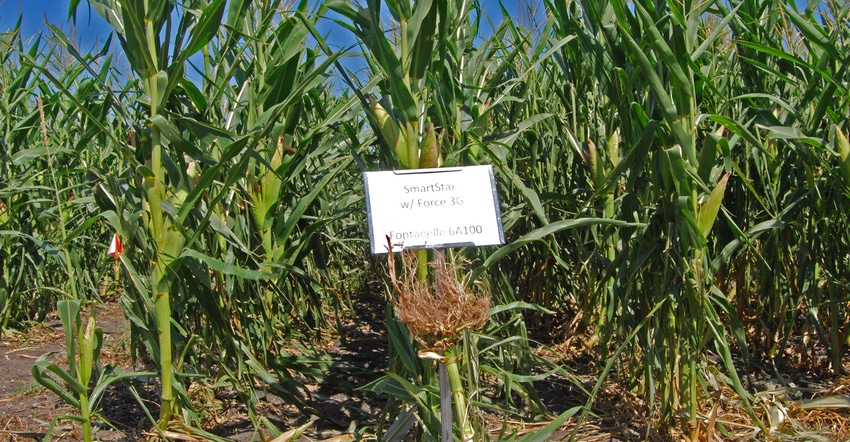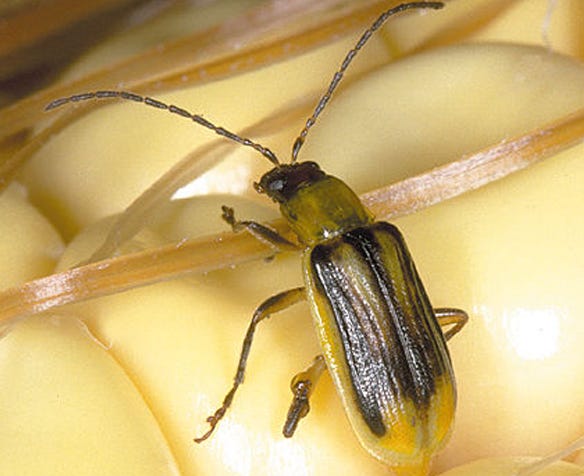December 17, 2018

Scientists have confirmed resistance for the western species of the corn rootworm to the fourth type of Bt trait (Cry34Ab1/Cry35Ab1) used in corn hybrids planted by farmers. This is the Herculex product trait, and the resistance to it was found in a field in Delaware County in northeast Iowa.
Corteva Agriscience, the ag division of DowDuPont, made the announcement in late October. Corteva reported it to the U.S. Environmental Protection Agency, which regulates Bt traits.
Previously, western corn rootworm resistance had been confirmed with three other Bt-traited products with Cry3 proteins: YieldGard rootworm (Cry3Bb1), Agrisure RW (mCry3A) and Agrisure Duracade (eCry3.1Ab).
Due to the reduction in effectiveness of the Cry3 proteins, more farmers have come to rely on Cry34Ab1/35Ab1, placing selection pressure on this trait. At this time, all four Bt rootworm traits are still effective on northern corn rootworm.
Diversify rootworm management
The Cry34Ab1/Cry35Ab1 trait is found in Herculex RW, SmartStax, Agrisure 3122, Intrasect Extra, Intrasect Xtreme, Qrome and certain AcreMax hybrids including AcreMax Xtra and AcreMax Xtreme.
While the Cry34Ab1/Cry35Ab1 protein is still effective in managing western corn rootworm in most areas, good stewardship of this trait is needed for it to remain useful. The best way to preserve the effectiveness of this technology is to diversify your corn rootworm management practices.
When looking at options to consider, farmers should rotate corn-on-corn fields to a nonhost crop (such as soybeans) at least once every five years. In most areas, no corn rootworm control is needed in first-year corn following a nonhost crop. Second-year corn on corn could use non-Bt corn hybrids with soil-applied rootworm insecticide. Third-year corn on corn could use Bt corn with pyramided Bt traits (contains two corn rootworm Bt proteins).
Need to use IPM approach
Corn rootworm has been referred to as the “$1 billion pest.” It was estimated farmers were losing $1 billion annually in the U.S. due to rootworm damage to corn roots before the development of Bt traits. The spread of rootworm resistance to these traits highlights the importance of using Integrated Pest Management approaches when dealing with insects, weeds and diseases.
Using IPM practices allows for better control, and will help maintain the effectiveness of both biotech and chemical technologies to delay or avoid resistance developing.
A new breeding technology called RNA interference (RNAi) may offer a new source of western corn rootworm control early in the next decade. However, stewardship of Bt traits is crucial even after that new technology is developed and becomes available. The full effectiveness of RNAi only comes when it is paired with an effective Bt protein trait to control northern corn rootworm.
Choosing Bt rootworm traits
Corn rootworm traits are valuable for corn growers, and every effort should be made to ensure these traits remain an effective tool for as long as possible.
Planting pyramided corn hybrids has been a recommended best management practice. The idea is if rootworms resist one Bt protein, the other Bt protein will control the pest. But this places selection pressure all on the remaining Bt protein. Over a period of years, this pressure can lead to development of rootworm resistance to the remaining Bt protein.
If trait failure has been documented in a corn hybrid, that doesn’t necessarily mean the trait will fail if you plant it in an area where resistance has occurred. The egg-laying corn rootworm beetles are not highly mobile; they don’t travel far from the original field. Even so, now that we’ve seen resistance to all four corn rootworm-resistant traits, this is a wake-up call for farmers to diversify their rootworm management strategies.
Rotating corn with soybeans
Rotating corn with soybeans or any non-corn crop still controls corn rootworm, in most cases. This is still one of the strongest management tactics we have for this pest. However, there are two exceptions.
The first exception is where the western corn rootworm variant exists. It is present in some areas in eastern Iowa. This variant occurs when females of the western corn rootworm species lay some of their eggs in neighboring soybean fields. These eggs can hatch the following year, and the resulting larva can feed on roots of corn planted in that field.

WESTERNS: Western corn rootworm adult beetles are yellow to green with a black stripe along the sides.

Another exception occurs in areas affected by extended diapause of the northern corn rootworm species. Extended diapause is when eggs are laid by northern corn rootworm beetles, and the eggs remain dormant in the soil through the following year when soybeans are planted in the field.

NORTHERNS: Northern corn rootworm adult beetles are green and, like the western species, lay eggs in soil.

Then when corn is planted in that field the year after soybeans, the eggs hatch and damage the corn roots. So, this is first-year corn, but it can be damaged if extended diapause rootworms are present in the field.
Managing continuous corn
Some farmers need to grow continuous corn to feed livestock, or there’s an ethanol plant nearby that buys corn. They are reluctant to rotate to something else. But some of them have switched to growing corn for three or four years and then planting a year of beans to break the rootworm life cycle and lower the overall rootworm population.
Some farmers in areas where a lot of continuous corn is planted have managed rootworm populations by spraying foliar insecticides in late July or early August that kill adult beetles. This is not recommended. Cornfields with resistant and susceptible corn rootworm have a higher percentage of susceptible beetles emerge first.
A foliar application would kill more of the susceptible population and leave more of the later-emerging resistant beetles to mate with each other, rather than mate with susceptible beetles. That would hasten the development of resistance rather than manage it.
Soil-applied insecticides at planting are another option to control corn rootworm. These products are still quite effective. However, performance is a little more variable for early planted corn. With corn planted in early April, you’re expecting control to last all the way through the rootworm egg hatch in June. Rootworm eggs hatch in June, and the larva (worms) then begin chewing on corn roots.
What about doubling up?
What about applying a soil insecticide at planting and using a Bt trait corn hybrid? Is “doubling up” a good option? This is expensive and consistent yield responses to this practice haven’t occurred in ISU research trials.
This practice also isn’t advisable from an IPM standpoint, as we are trying to manage the development of rootworm resistance. We don’t want resistance to develop to everything: traits and insecticide.
Know field population
With low corn prices continuing in 2019, you need to invest in crop protection management where it will do the most good. Continuous corn usually needs corn rootworm protection, but there are options with crop rotation, soil insecticide or pyramid traits.
Monitoring corn rootworm beetle populations in late July through August, and noting the species (western or northern) present in fields can provide additional information regarding management choices the following year.
In areas plagued by problems with the western corn rootworm variant or with extended diapause of northern corn rootworm, a soil-applied insecticide on first-year corn could provide extra protection for the corn if the rootworm population in the field is decreased by the preceding soybean year. For the second year of corn in that field, consider planting a pyramid Bt trait hybrid.
Summing up: Corn rootworms are an incredibly adaptable and challenging pest. Managing resistance is the key to staying ahead of this yield robber.
Visit ent.iastate.edu, where ISU’s annual insecticide trails on corn rootworm are posted along with more management information.
Lang is an ISU Extension field agronomist at Decorah in northeast Iowa. Contact him at [email protected].
About the Author(s)
You May Also Like






